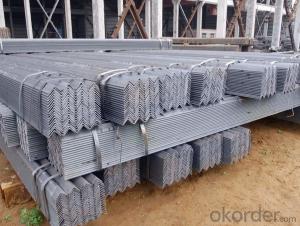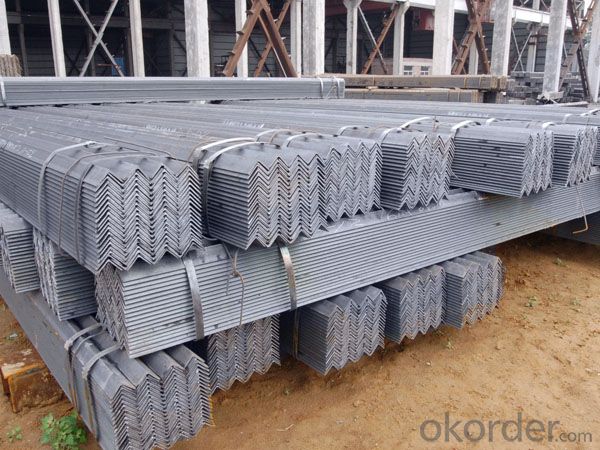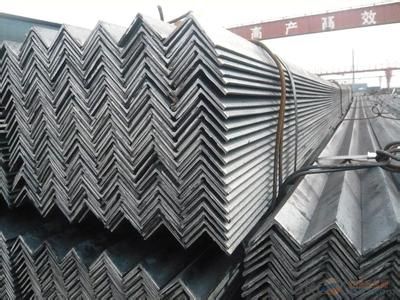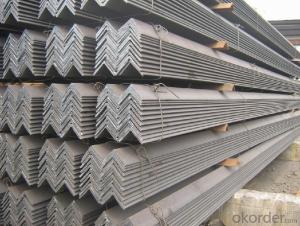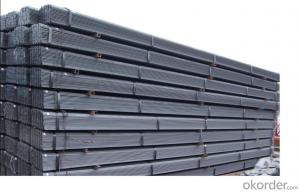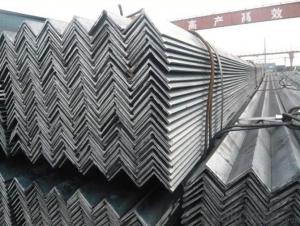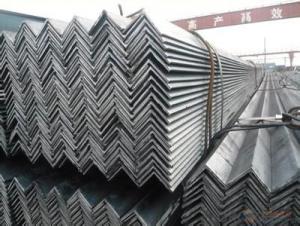Angle steel GB Q235 ASTM A36 high quality
- Loading Port:
- Tianjin
- Payment Terms:
- TT OR LC
- Min Order Qty:
- 25 m.t.
- Supply Capability:
- 20000 m.t./month
OKorder Service Pledge
OKorder Financial Service
You Might Also Like
Angle Steel Details:
| Minimum Order Quantity: | 25mtons | Unit: | m.t. | Loading Port: | China Main Port |
| Supply Ability: | 80000-100000MTS/YEAR | Payment Terms: | TT or LC |
Product Description:
Specifications of Angle Steel
1. Invoicing on theoretical weight or actual weight as customer request
2. Length: 6m, 9m, 12m as following table
3. Sizes
Sizes: 25mm-250mm | ||
a*t | ||
25*2.5-4.0 | 70*6.0-9.0 | 130*9.0-15 |
30*2.5-6.6 | 75*6.0-9.0 | 140*10-14 |
36*3.0-5.0 | 80*5.0-10 | 150*10-20 |
38*2.3-6.0 | 90*7.0-10 | 160*10-16 |
40*3.0-5.0 | 100*6.0-12 | 175*12-15 |
45*4.0-6.0 | 110*8.0-10 | 180*12-18 |
50*4.0-6.0 | 120*6.0-15 | 200*14-25 |
60*4.0-8.0 | 125*8.0-14 | 250*25 |
5. Payment terms:
1).100% irrevocable L/C at sight.
2).30% T/T prepaid and the balance against the copy of B/L.
3).30% T/T prepaid and the balance against L/C
6.Material details:
Alloy No | Grade | Element (%) | |||||
C | Mn | S | P | Si | |||
|
|
|
|
|
|
| |
Q235 | B | 0.12—0.20 | 0.3—0.7 | ≤0.045 | ≤0.045 | ≤0.3 | |
|
|
|
|
|
|
| |
Alloy No | Grade | Yielding strength point( Mpa) | |||||
Thickness (mm) | |||||||
≤16 | >16--40 | >40--60 | >60--100 | ||||
≥ | |||||||
|
|
|
|
|
| ||
Q235 | B | 235 | 225 | 215 | 205 | ||
Alloy No | Grade | Tensile strength (Mpa) | Elongation after fracture (%) | ||||
Thickness (mm) | |||||||
| ≤16 | >16--40 | >40--60 | >60--100 | |||
≥ | |||||||
|
|
|
|
|
|
| |
Q235 | B | 375--500 | 26 | 25 | 24 | 23 | |
Usage & Applications of Angle Steel
According to the needs of different structures, Angle can compose to different force support component, and also can be the connections between components. It is widely used in various building structures and engineering structures such as roof beams, bridges, transmission towers, hoisting machinery and transport machinery, ships, industrial furnaces, reaction tower, container frame and warehouse etc.
Packaging & Delivery of Angle Steel
1. Packing: it is nude packed in bundles by steel wire rod
2. Bundle weight: not more than 3.5MT for bulk vessel; less than 3 MT for container load
3. Marks:
Color marking: There will be color marking on both end of the bundle for the cargo delivered by bulk vessel. That makes it easily to distinguish at the destination port.
Tag mark: there will be tag mark tied up on the bundles. The information usually including supplier logo and name, product name, made in China, shipping marks and other information request by the customer.
If loading by container the marking is not needed, but we will prepare it as customer request.
Production flow of Angle Steel
Material prepare (billet) —heat up—rough rolling—precision rolling—cooling—packing—storage and transportation
- Q: What are the different dimensions used to specify steel angles?
- The specific standards and systems followed by various countries or industries determine the different dimensions used to specify steel angles. However, there are some commonly used dimensions for specifying steel angles. 1. Leg Length: The length of each of the two equal legs that form the angle is referred to as the leg length of a steel angle. Typically, this dimension is measured from the inside of the angle and is denoted in millimeters or inches. 2. Thickness: The measurement of the material's thickness from one side to the other is known as the thickness of a steel angle. It is usually expressed in millimeters or inches. 3. Weight per Meter or Foot: The weight per unit length is a significant dimension used to specify steel angles. It represents the weight of the angle per unit length and is calculated by multiplying the cross-sectional area of the angle by the density of the steel. The weight is commonly provided in kilograms per meter (kg/m) or pounds per foot (lb/ft). 4. Cross-Sectional Area: The total area of the steel angle's cross-section is referred to as the cross-sectional area. It is calculated by multiplying the leg length and the thickness of the angle. The cross-sectional area is typically expressed in square millimeters or square inches. 5. Moment of Inertia: The moment of inertia measures the resistance of the steel angle to bending and is calculated based on the shape and dimensions of the angle's cross-section. It is commonly denoted as Ixx or Iyy and is expressed in millimeters to the fourth power or inches to the fourth power. 6. Radius of Fillet: The rounded corner between the legs of the steel angle is called the radius of fillet. It is measured from the inside of the angle and is typically expressed in millimeters or inches. These dimensions play a crucial role in specifying steel angles as they provide essential information about the size, weight, strength, and structural properties of the angles. They assist engineers, architects, and manufacturers in selecting the appropriate steel angles for various applications, including construction, infrastructure, machinery, and fabrication.
- Q: Can steel angles be used for support brackets in electrical installations?
- Yes, steel angles can be used as support brackets in electrical installations. Steel angles provide strength, durability, and stability, making them suitable for supporting heavy electrical equipment or mounting electrical panels securely. Additionally, their rigid structure ensures proper alignment and minimizes the risk of shifting or sagging over time.
- Q: Can steel angles be used for transmission towers?
- Yes, steel angles can be used for transmission towers. Steel angles provide structural strength and support, making them suitable for constructing transmission towers that need to withstand various weather conditions and carry heavy loads.
- Q: How do steel angles perform under dynamic loads?
- Steel angles generally perform well under dynamic loads due to their inherent strength and durability. The structural shape of steel angles, characterized by their L-shaped cross-section, provides excellent resistance to bending and torsional forces. This design allows them to efficiently distribute dynamic loads and resist deformation, making them suitable for various applications in construction, engineering, and manufacturing industries. However, the specific performance of steel angles under dynamic loads can vary depending on factors such as the grade and quality of the steel, the magnitude and frequency of the dynamic load, and the overall design and reinforcement of the structure.
- Q: Are steel angles resistant to impact?
- Steel angles possess exceptional strength and durability, rendering them highly resistant to impact. Their ability to withstand substantial forces without deforming or breaking can be attributed to their structural design and composition. The hardness and toughness of steel contribute to this impact resistance by enabling it to absorb and dissipate energy from external forces. Moreover, the impact resistance of steel angles can be augmented by reinforcing or coating them, consequently making them a favored choice in various fields including construction, automotive manufacturing, and industrial machinery. However, it is crucial to acknowledge that the impact resistance of steel angles can differ based on factors such as the specific grade of steel employed, the dimensions of the angle, and the manner in which it is installed or utilized.
- Q: Can steel angles be used in the construction of hospitals?
- Yes, steel angles can be used in the construction of hospitals. Steel angles are commonly used in construction projects as they provide structural support and stability. In the construction of hospitals, steel angles can be used in various applications such as framing, support beams, trusses, and reinforcement for walls and floors. Steel angles are known for their strength, durability, and resistance to fire, making them suitable for withstanding the high demands and safety requirements of hospital buildings. Additionally, steel angles can be easily fabricated and manipulated to fit the specific design and structural requirements of a hospital, allowing for flexibility in construction. Overall, steel angles are a reliable and versatile material that can be effectively used in the construction of hospitals.
- Q: Can steel angles be used for overhead cranes?
- Yes, steel angles can be used for overhead cranes. Steel angles provide structural support and stability to the crane, making them a suitable choice for constructing the framework of overhead cranes. They are strong, durable, and capable of withstanding heavy loads, making them an ideal material for such applications.
- Q: What is the maximum allowable torsional stress for a steel angle?
- Several factors determine the maximum allowable torsional stress for a steel angle, including the specific grade of steel, the dimensions and shape of the angle, and the intended application. Steel angles are commonly used in structural applications, such as supporting beams and frames, and they are designed to withstand various types of stresses, including torsional stress. Engineers typically consult industry standards and codes, such as the AISC Manual or EN 10056, to determine the maximum allowable torsional stress for a steel angle. These standards provide guidelines and formulas for calculating the maximum allowable torsional stress based on properties like the cross-sectional area, moment of inertia, and modulus of elasticity of the steel angle. It is important to note that the maximum allowable torsional stress is usually expressed as a percentage of the steel's yield strength or ultimate tensile strength. This ensures that the angle can safely endure torsional loads without suffering permanent deformation or failure. In practical applications, engineers and designers carefully analyze specific requirements and loading conditions to determine the appropriate maximum allowable torsional stress for a steel angle. They consider factors such as the magnitude and direction of the applied torque, the angle's orientation, and any additional loads or constraints present. Ultimately, the maximum allowable torsional stress for a steel angle is a critical parameter in ensuring the structural integrity and safety of a design. Proper consideration of the steel's properties, industry standards, and specific application requirements is essential for accurate calculations and the selection of an appropriate steel angle capable of effectively resisting torsional stress.
- Q: Can steel angles be used in modular building systems?
- Indeed, modular building systems can utilize steel angles. Due to their strength and versatility, steel angles are frequently employed in construction. These angles contribute structural support and stability to the building system. In the realm of modular construction, steel angles serve as framing members, connectors, or reinforcements, depending on the specific design requirements. They can effortlessly be attached and integrated into the modular system, enabling efficient and cost-effective construction. Furthermore, steel angles possess durability and resistance to diverse environmental factors, rendering them suitable for modular buildings that must endure various conditions. All in all, steel angles constitute a dependable and pragmatic option for modular building systems.
- Q: What are the design considerations for using steel angles in architectural applications?
- Some design considerations for using steel angles in architectural applications include structural stability, load-bearing capacity, aesthetic appeal, corrosion resistance, and ease of installation. Steel angles are commonly used to provide support, reinforcement, and stability to various architectural elements such as beams, columns, and frames. The selection of the appropriate size, thickness, and grade of steel angle is crucial to ensure the structural integrity and safety of the building. Additionally, architects may consider the visual impact of steel angles, as they can be exposed or concealed depending on the design intent. The corrosion resistance properties of the steel angles should also be taken into account, especially in applications where exposure to moisture or harsh environments is expected. Lastly, the ease of installation and compatibility with other building materials should be considered to streamline the construction process.
Send your message to us
Angle steel GB Q235 ASTM A36 high quality
- Loading Port:
- Tianjin
- Payment Terms:
- TT OR LC
- Min Order Qty:
- 25 m.t.
- Supply Capability:
- 20000 m.t./month
OKorder Service Pledge
OKorder Financial Service
Similar products
Hot products
Hot Searches
Related keywords
